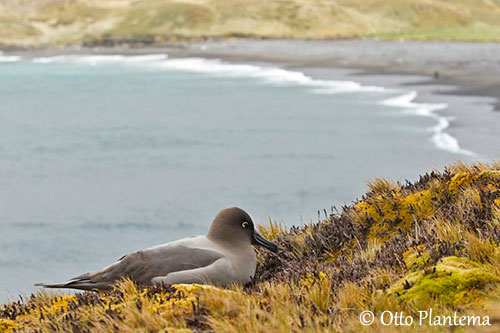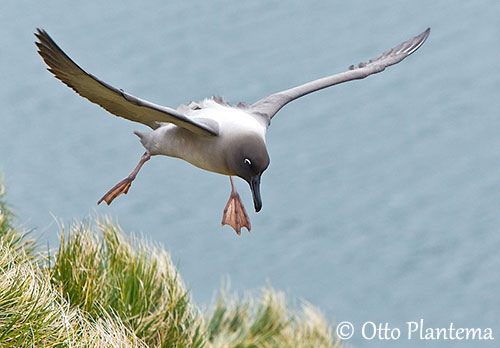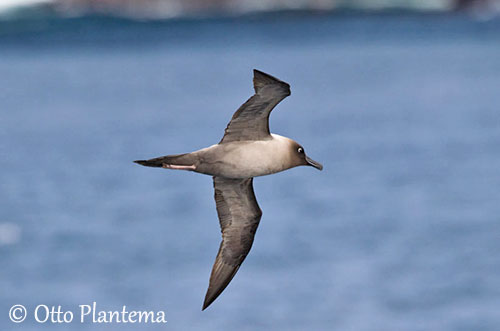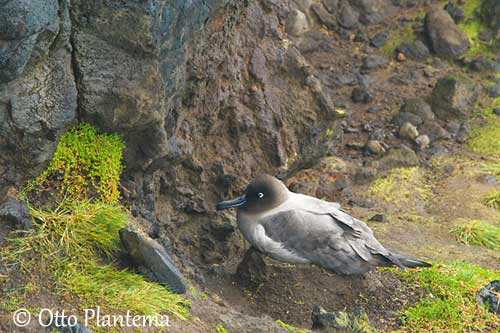
Fr: Albatros fuligineux
All : Graumantel-Rußalbatros
Esp: Albatros Tiznado
Ital: Albatro palpebrato
Nd: Roetkopalbatros
Sd: Ljusryggad sotalbatross
Photographer:
Otto Plantema
Trips around the world
Text by Nicole Bouglouan
Sources:
HANDBOOK OF THE BIRDS OF THE WORLD vol 1 by Josep del Hoyo-Andrew Elliot-Jordi Sargatal - Lynx Edicions - ISBN: 8487334105
BirdLife International (BirdLife International)
New Zealand birds and birding (Narena Olliver)
Australian Antarctic Division: Leading Australia's Antarctic Program
Department of Sustainability, Environment, Water, Population and Communities
Wikipedia, the free encyclopaedia
Light-mantled Albatross
Phoebatria palpebrata
Procellariiforme Order – Diomedeidae Family
INTRODUCTION:
The Light-mantled Albatross and the Sooty Albatross (P. fuscus) belong to the genus Phoebatria. Both species are very similar, with sooty brown to sooty grey plumage overall, but the Light-mantled Albatross shows pale mantle, as described in the name of the species.
This species was also named “Blue Bird” by the sealers seeing the bird with blue plumage in the strong Antarctic light.
It was described in 1785 by the naturalist Johann Reinhold Forster.
DESCRIPTION OF THE BIRD:
Biometrics:
Length: 78-79 cm
Wingspan: 183-218 cm
Weight: 2800-3100 g
The adult has sooty brown plumage. The head is darker, whereas the body is mostly paler and greyer. Mantle, back and underparts are pale ash grey and much paler than rump and uppertail-coverts.
The sooty brown/grey scapulars and upperwing contrast with the paler upperparts. The tail is fairly dark too.
The head is dark sooty brown, mainly on face and crown, fading into paler brownish-grey on nape and rear neck.
The bill is black, with narrow pale blue line along the cutting edge of the lower mandible. The eyes are dark brown with conspicuous partial white eyering on both upper and lower half of the eye. Legs and webbed feet are pale pinkish-grey.
Both adults are similar.

The juvenile resembles adult, but it has usually duller, mostly grey, eyering, flight feathers’ shafts and bill pattern.
The chick has pale greyish down. On the head, the face is darker with white loral area and broad eyering.
RANGE:
The Light-mantled Albatross has circumpolar range in Southern Ocean. It breeds from South Georgia E to Campbell and Antipodes Islands.
HABITAT:
The Light-mantled Albatross is pelagic and marine. It usually occurs in colder waters than P. fusca, over the continental shelf but also in deeper waters in Southern Ocean.
It breeds on remote sub-Antarctic islands and rocky islets. The nest-site is established on cliff ledges and steep slopes. However, it may also nest inland, among tussock grass and ferns.

CALLS AND SONGS: SOUNDS BY XENO-CANTO
The Light-mantled Albatross, like other albatrosses, produces the typical rattling sound by quick bill-clattering. Cries, grunts and moans are heard too during displays. It is silent at sea but it gives eerie calls in flight.
BEHAVIOUR IN THE WILD:
The Light-mantled Albatross feeds mainly on cephalopods such as squid and octopus, caught at night. It also consumes fish, krill, crustaceans and floating carrion.
It forages at sea. The preys are caught by surface-seizing, while floating on the water. It plucks the food items with the bill.
It may occasionally perform surface-diving by diving underwater while floating, and also surface-plunging by plunging into the water while flying. The bird is partially submerged or just below the surface.
It usually forages alone, but it may sometimes feed with the Wandering Albatross (D. exulans) and with cetaceans. It follows the fish boats too.

The Light-mantled Albatross can start breeding at 6 years old, but usually mostly at 12 years old. This species is long-lived with a lifespan of about 30-32 years.
Mates pair for life. They perform long sequences of stereotyped postures during displays, accompanied by various sounds and calls. These displays are performed while the birds are facing each other.
The Light-mantled Albatross has low breeding productivity throughout the range. It has biennial breeding rate and one pair produces on average one young every 3-4 years.

After the breeding season, the Light-mantled Albatross disperses widely over the Southern Ocean. They travel northwards and can reach subtropical waters, depending on the pack ice expansion. They return to the colonies in September/October. Throughout the breeding season, the adults perform long-distance foraging trips, between 1500 and 2200 km from the breeding site. Short and longer foraging trips are performed alternately when they are feeding the chick.
The Light-mantled Albatross does not need to run for taking-off. It propels itself outwards from the steep slope where it is nesting. Its agile flight allows elaborated aerial courtship displays. This albatross is a graceful glider.


REPRODUCTION OF THIS SPECIES:
The breeding season occurs between September/October and May/June.
The Light-mantled Albatross often breeds solitary, but it can sometimes form very loose colonies. The nest-site is established on cliff ledges and steep slopes, usually backed by rock or earth.
Both adults build a low truncated cone-shaped nest with mud and plant materials.

The female lays one single white egg with darker spots. Male and female incubate during 63-71 days, with stints of 4-24 days. The downy chick is fed by regurgitation by both parents. It fledges between 140 and 170 days after hatching.
PROTECTION / THREATS / STATUS:
The Light-mantled Albatross is always threatened by interactions with long line fishing operations. The bird can be injured or killed by ingestion of baited hooks when following the fish boats. In the same way, they can be killed by drowning when they are dragged underwater by the heavy fishing gear.
Introduced cats and rats, and natural avian predators kill the chicks at nest. Adults are vulnerable to marine pollution and disturbances.
The Light-mantled Albatross is currently classified as Near Threatened.
